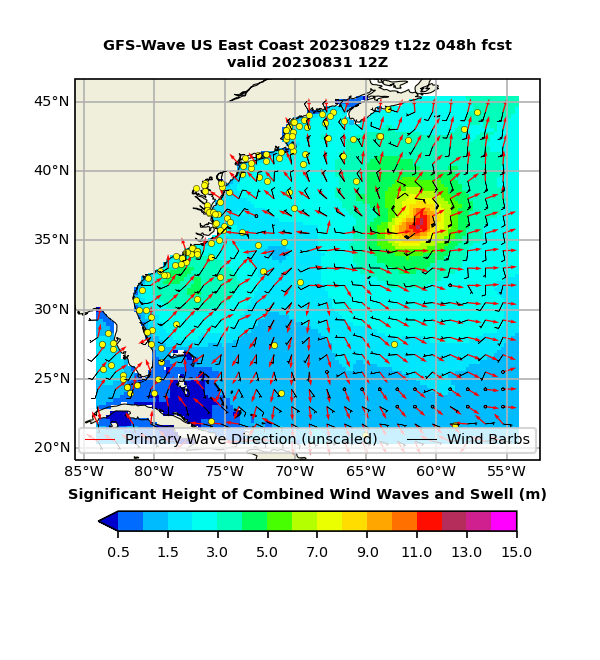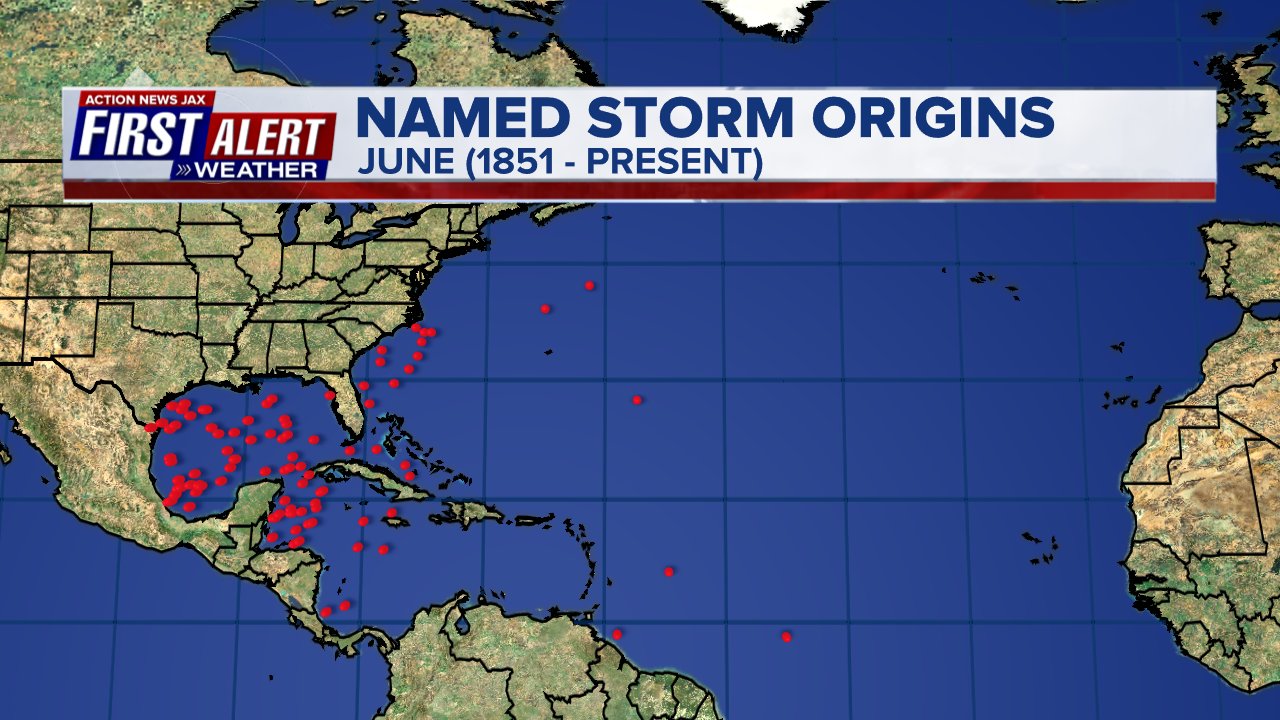Jacksonville, Fl. — The “Buresh Bottom Line”: Always be prepared!.....First Alert Hurricane Survival Guide... City of Jacksonville Preparedness Guide... Georgia Hurricane Guide.
STAY INFORMED: Get the * FREE * First Alert Weather app
FREE NEWS UPDATES, ALERTS: Action News Jax app for Apple | For Android
WATCH “Preparing for the Storm”
WATCH “The Ins & Outs of Hurricane Season”
READ the First Alert Hurricane Center “Survival Guide”
LISTEN & WATCH “Surviving the Storm” - WOKV Radio & Action News Jax
***** ALWAYS CHECK & RE-CHECK THE LATEST FORECAST & UPDATES! *****
REMEMBER WHEN A TROPICAL STORM OR HURRICANE IS APPROACHING: Taping windows is *NOT* helpful & will not keep glass from breaking.
Realize the forecast cone (”cone of uncertainty”) is the average forecast error over a given time - out to 5 days - & *does not* indicate the width of the storm &/or damage that might occur.
Tropics:
* A nontropical low is moving over the NW Atlantic - to the N/NE - & will bring some wind & heavy rain to Nova Scotia & Newfoundland. Tropical development is not likely.
* An active tropical wave - now ‘94-L’ came off the coast of Africa Wed. & is chugging westbound. Little development is expected in the short term... but this wave has long term potential as conditions for development do appear more favorable next week once the wave has traversed a large plume of African dust & dry mid & upper level air. The low latitude track makes the intensity forecast a little tricky, but it does appear the upper level high will remain intact across the Atlantic & U.S. (Lower 48) which would result in a rather straight forward forecast track. The question then becomes one about shear & any land interaction relating to intensity. The GFS & European long range global forecast models are just about on top of one another (remarkably) with some possible interaction with S. America followed by “bowling ball” west into Central America in about 8-10 days (early July/next weekend). Such a track would imply no impacts on NE Fl./SE Ga. ... or any of Florida... & probably not any of the Gulf Coast. Of course, still early on this one. It is worth noting early season African waves are often a harbinger of an overall active Atlantic hurricane season.
Another tropical wave is following ‘94-L’ just off the coast of Africa but forecast models indicate little development.... at this point.
* There’s a good deal of storminess (convection) over the far SW Caribbean. Proximity to land will likely preclude much surface development, but this is still something to keep an eye on.




Wind shear analysis shows winds out of the west at more than 50 mph! over parts of the Southern Gulf & N. Caribbean:

The location of development of tropical systems in June since 1851 generally favors the NW Caribbean, Gulf of Mexico & far Western Atlantic:




Saharan dust is spread west each year from Africa by the prevailing winds (from east to west over the Atlantic). Dry air - yellow/orange/red/pink. Widespread dust is indicative of dry air that can impede the development of tropical cyclones. However, sometimes “wanna’ be” waves will just wait until they get to the other side of - or away from - the plume then try to develop if other conditions are favorable. In my personal opinion, way too much is made about the presence of Saharan dust & how it relates to tropical cyclones. In any case, we’ve already has a couple of dust plumes spread west to the Caribbean & Gulf with the peak of Saharan dust typically in June & July.

2022 names..... “Alex” was the first name on the Atlantic list (names are picked at random by the World Meteorological Organization... repeat every 6 years... “Bonnie” is next. Historic storms are retired [Florence & Michael in ’18... Dorian in ’19 & Laura, Eta & Iota in ‘20 & Ida in ‘21]). The WMO decided - beginning last year - that the Greek alphabet will be no longer used & instead there will be a supplemental list of names if the first list is exhausted (has only happened three times - 2005, 2020 & 2021). The naming of tropical cyclones began on a consistent basis in 1953. More on the history of naming tropical cyclones * here *.





East Atlantic:





Mid & upper level wind shear (enemy of tropical cyclones) analysis (CIMMS). The red lines indicate strong shear:
Water vapor imagery (dark blue indicates dry air):

Deep oceanic heat content over the Gulf, Caribbean & deep tropical Atlantic:

Sea surface temp. anomalies:


SE U.S. surface map:

Surface analysis centered on the tropical Atlantic:

Surface analysis of the Gulf:

Caribbean:

GFS wave forecast at 48 & 72 hours (2 & 3 days):


Atlantic Basin wave period forecast for 24, 48 & 72 hours respectively:




The East Pacific:
“Celia” is now steadily organizing/strengthening over the far East Pacific well south & west of Mexico & well south of the Baja of California. Further strengthening should occur through Friday before Celia moves over cooler water & begins to weaken. No impact to major land areas expected.



West Pacific IR satellite:

Global tropical activity:

Cox Media Group

:quality(70)/cloudfront-us-east-1.images.arcpublishing.com/cmg/WW5AJL3ARQUGDQMAQUNSFX4CLE.jpg)


:quality(70)/cloudfront-us-east-1.images.arcpublishing.com/cmg/HJ3L3HBBJBH6PB5ZFB3SVGFXSU.png)
:quality(70)/cloudfront-us-east-1.images.arcpublishing.com/cmg/SKX4RKW645ERTATCLA4V2FVRKQ.png)
:quality(70)/cloudfront-us-east-1.images.arcpublishing.com/cmg/SCWUKX27NRFXVFR2KCQYQ3ZPQY.jpg)
:quality(70)/cloudfront-us-east-1.images.arcpublishing.com/cmg/IXRWSGOXBJASFLY7MMQHY4TUZU.jpg)
:quality(70)/cloudfront-us-east-1.images.arcpublishing.com/cmg/V7JDMMD6JJEEHIL6C7OSLV3ABU.png)
:quality(70)/cloudfront-us-east-1.images.arcpublishing.com/cmg/MC6ZPFJWWT7KEUMMEGLTSO73UE.jpg)
:quality(70)/cloudfront-us-east-1.images.arcpublishing.com/cmg/BR6PWNNNW3VNN4SPDQUTGFDHGA.jpg)
